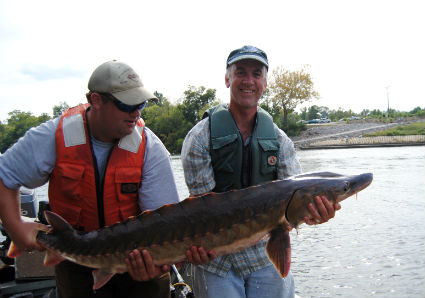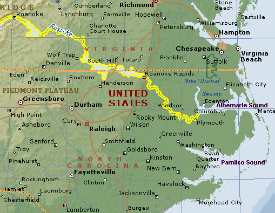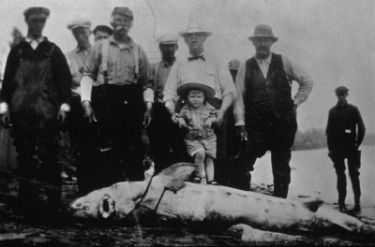 Jeremy McCargo, left, of the N.C. Wildlife Resources Commission and Joseph Hightower of N.C. State University hold a tagged Atlantic sturgeon just before releasing it in the Roanoke River. Photo: Chad Thomas, NCWRC Jeremy McCargo, left, of the N.C. Wildlife Resources Commission and Joseph Hightower of N.C. State University hold a tagged Atlantic sturgeon just before releasing it in the Roanoke River. Photo: Chad Thomas, NCWRC |
An endangered fish leaping in a North Carolina river has created waves in fish science that could lead to better protection for the entire species, which dates to the dinosaurs.
The fisherman who witnessed that prodigious leap in the traditional spawning grounds high up Roanoke River in the fall of 2009 had no doubt it was an Atlantic sturgeon, says Fritz Rohde, a Beaufort-based biologist for the National Marine Fisheries Service. “A big fish that comes out of the water like that, they’re very distinctive,” he noted.
Supporter Spotlight
The prehistoric-looking fish with five rows of bony protuberances down its length can reach 14 feet and 800 pounds, according to the National Oceanic and Atmospheric Administration. Its lifespan almost rivals humans’, at 60 years.
Once common along the N.C. coast, Atlantic sturgeon (Acipenser oyxrinchus oxyrinchus) was prized for its fleshy white meat and abundant roe for caviar. The fish became so rare that to preserve the remaining population the state more than 20 years ago made it illegal to possess a sturgeon. The federal government last year placed it on the Endangered Species List.
Until the Roanoke leap, scientists were aware of young fish in the estuaries of the state’s big coastal rivers – the Roanoke, the Cape Fear, and the Neuse. But how they got there was a mystery because no adults were being sighted at spring spawning time in traditional spawning grounds, the rocky bottoms of the fall line where the piedmont meets the coastal plain.
Since that leap, spawning-ready sturgeon weighing an estimated 50 to 70 pounds have been captured for three succeeding autumns, rather than spring, in the Roanoke near Weldon. Joseph Hightower of N.C. State University and the U.S. Geological Survey conducted the study, along with NCSU graduate student Jared Flowers and representatives of the N.C. Wildlife Resources Commission and the N.C. Division of Marine Fisheries.
Last September, they came up with what they consider the Holy Grail, a fertilized egg. It was deposited on a bristly floor-sander pad attached to the river bottom to simulate pebbles.
Supporter Spotlight
They popped the egg in a fish tank at NCSU, where “that little thing hatched into a little sturgeon,” Hightower says.
 The Roanoke River in North Carolina and Virginia. |
The one-inch long fish was returned to the Roanoke, and now, “Hopefully it’s hanging out in Albemarle Sound until it gets a little bigger,” Hightower says.
Starting in 2009, sturgeon have been similarly confounding Virginia scientists with tantalizing clues of a fall spawning in the James River.
At Hopewell, Va., a freshwater site about 25 miles southeast of Richmond, researchers from Virginia Commonwealth University’s Center for Environmental Studies have handled nearly 300 fish, some nearly six feet long.
“In the fall, most of the males are just running milt (seminal fluid), just running down the side of the fish,” says Greg Garman, center director.
A female captured last fall by graduate student Matt Balazik was “throwing eggs,” says Garman. Females drop eggs in the water to be fertilized by sperm.
Balazik was only able to collect a few unfertilized eggs “before the female tore out of the gill net and swam away. It was a brief encounter, but these are big, powerful fish and when they decide they want to leave, there’s not a whole lot you’re going to do about it,” Garman says.
Other sturgeon gave downtown Richmond, presumed to be part of their traditional spawning grounds, quite a start last fall. Several adults were spotted swimming in three to four feet of water under the 14th Street Bridge, next to the financial district and surrounded by skyscrapers.
“People were lining the bridge, taking pictures, bringing their kids,” Garman recalls.
There hasn’t been a sturgeon caught in Richmond since the late 1940s, he says. Some 10 years ago, “Most of us here thought the sturgeon was gone from the James and probably from Chesapeake Bay,” Garman says.
In preceding centuries, N.C. and Virginia waters teemed with the sturgeon, praised by Hightower as “such a neat fish.” Despite their science-fiction looks, the creatures aren’t harmful to humans. They use their pointed snouts, shark-like tails and sucker-like mouths to scarf up snails and worms from the ocean floors.
Adults, which periodically take prodigious leaps for no apparent reason, swim as far as Nova Scotia. Juveniles wait until they’re about a yard long before venturing out into the ocean from the estuaries.
Overfishing, dams that blocked their passage to spawning grounds, plus a general lack of understanding of their slow maturation are all thought to have brought them to their diminished state.
“People didn’t understand sturgeon biology, so they were overfished in short order,” says Hightower.
 Once fished heavily, Atlantic sturgeon were prized for their roe and fleshy white meat. This big one was caught in the Potomac River. Photo: Library of Congress |
By 1998, there were so few on the East Coast that, like North Carolina, all states had placed moratoria against their capture. Then, the big fish went on the endangered list.
So why are the sturgeon showing up now, and in the fall, when common wisdom considered them to be spring spawners like other fish that live in the ocean but spawn in freshwater rivers?
They are, says Hightower, “a hard-to-detect species unless they jump; they can be there but nobody knows it. They live in deep holes typically. They don’t strike at a lure.
“They were obviously there and people just didn’t realize it.”
A fall spawning run may have gone on “under the radar” because people were focused on the more abundant spring spawns of the past, he says.
Bennett Wynne, anadromous fish coordinator for the state’s wildlife commission, also points out that 15 years have passed since catching them on the East Coast became illegal, long enough for some young fish to have gained adulthood.
In Virginia, “what we think we’re seeing in the James right now is a bit of a population recovery, and we aren’t quite sure why,” says Garman. “Certainly the fact that there are fishing harvest moratoria – you can’t legally capture them – that’s helped, and maybe water quality in the James has improved enough that they’re able to come back.”
Rohde expects the Roanoke’s sturgeon to be on the agenda at an upcoming conference on Kerr Scott Dam, which is managed by the Army Corps of Engineers with input from the protective services division of the National Marine Fisheries Service. Water releases from Kerr feed the Roanoke.
“We really don’t know what flows are needed,” says Rohde. “Obviously there’s enough flow going on right now (in the fall) that the sturgeon are spawning.”
A separate, multi-agency, NOAA-funded study of sturgeon migration patterns in the Carolinas and Georgia rivers is already upending some conventional wisdom.
Chip Collier of the marine fisheries division has captured and tagged what he calls a “surprising” number of Atlantic sturgeon – 80 – plus two of their rarer and smaller cousins, the shortnose sturgeon, in the Cape Fear and Northeast Cape Fear estuaries.
Most of the Atlantics were juveniles, but the biggest he caught was a 70- to 80-pound adult, he says. “When a big one jumps, it sounds like a tree fell in the water,” Collier reports.
The shortnose, thought to be homebodies that don’t venture into the ocean, were tracked leaving North Carolina and swimming up rivers in South Carolina and Georgia.
This spring, Collier hopes his tracking shows sturgeon making it over the new $13 million rock arch rapids on the Cape Fear above Wilmington. The manmade rapids, a sloping wall of rock leading up to a 11-foot dam, was completed last fall as an aid to spawning fish of several species.
His and the other researchers’ task, he says, is to identify “hot spots” where sturgeon congregate so that those river areas can be protected from threats like dredging and wastewater dumping
Hightower would like to see the Atlantics muscle their way to the kind of comeback their cousins, the Gulf sturgeon, enjoy.
Listed as threatened in 1991, those fish have rebounded to the point that unwary boaters and water skiers on Florida rivers are warned, “Beware of airborne sturgeon,” he says.







